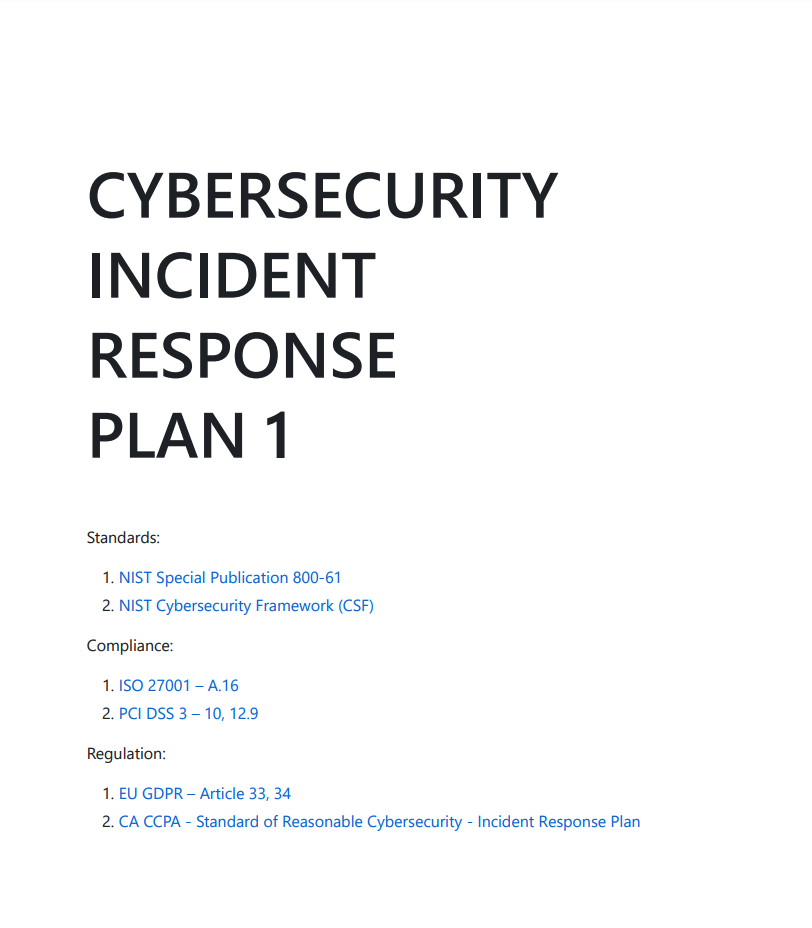
Cybersecurity Incident Response Plan (CIRP) Plan 1 & Plan 2
A strong Cybersecurity Incident Response Plan is crucial in today's threat landscape. By following a structured approach—from preparation to recovery—organizations can effectively mitigate cyber threats, protect their digital assets, and ensure compliance with global security standards. Cybersecurity is not just about defense; it's about proactive resilience and continuous improvement.
Cybersecurity Incident Response: A Strategic Approach to Handling Threats
In today's digital era, cybersecurity threats have become a critical challenge for organizations worldwide. A well-structured Cybersecurity Incident Response Plan (CIRP) is essential to mitigate risks, protect sensitive data, and ensure business continuity. This article explores the key components of an effective cybersecurity incident response strategy, aligned with industry regulations and best practices.
Understanding Cybersecurity Incidents
Cybersecurity incidents refer to events that indicate a breach of security policies or a compromise of digital assets. These incidents range from malware attacks, ransomware infections, phishing attempts, and unauthorized access to critical systems.
Key Definitions
Event: An observable occurrence within a network (e.g., login attempts, file transfers, firewall logs).
Alert: A security notification indicating potential malicious activity.
Incident: A confirmed security breach or an imminent threat requiring immediate action.
Regulatory and Compliance Frameworks
Organizations must adhere to cybersecurity regulations such as:
EU GDPR (Article 33 & 34) – Requires organizations to notify authorities and affected individuals in case of a data breach.
ISO 27001 (A.16) – Outlines incident management requirements.
PCI DSS (3.10, 12.9) – Sets security measures for payment systems.
NIST 800-61 & Cybersecurity Framework (CSF) – Provides best practices for incident handling.
The Incident Response Lifecycle
A robust Cybersecurity Incident Response Plan (CIRP) follows a structured framework known as the PICERL model:
1. Preparation
✅ Establish an Incident Response Team (CSIRT & ISO)
✅ Implement security technologies (SIEM, IDS/IPS, firewalls, endpoint protection)
✅ Conduct cybersecurity risk assessments and penetration testing
✅ Train employees on threat awareness and reporting
2. Identification
✅ Monitor security alerts and anomaly detection tools
✅ Conduct threat intelligence and log analysis
✅ Encourage employees to report suspicious activities
✅ Assess potential security incidents based on severity levels
3. Containment
✅ Isolate compromised systems to prevent further spread
✅ Block compromised accounts and restrict access
✅ Conduct forensic analysis to understand the scope of the attack
✅ Maintain a chain of custody for digital evidence
4. Eradication
✅ Remove malware and unauthorized access
✅ Patch vulnerabilities and improve security configurations
✅ Strengthen security controls to prevent future incidents
✅ Document all remediation actions taken
5. Recovery
✅ Restore from secure backups
✅ Verify system integrity and security configurations
✅ Monitor for any signs of re-infection or residual threats
✅ Implement additional safeguards and security enhancements
6. Lessons Learned
✅ Conduct post-incident reviews and analyze root causes
✅ Document findings and update response procedures
✅ Improve detection, prevention, and response capabilities
✅ Conduct training and awareness programs for employees
Best Practices for an Effective Incident Response Plan
To enhance cybersecurity resilience, organizations should:
Implement the MITRE ATT&CK Framework for threat detection and adversary tactics analysis.
Regularly update security policies to align with evolving threats and regulatory changes.
Maintain a digital forensic evidence locker to ensure proper investigation and legal compliance.
Engage external cybersecurity partners for additional expertise in threat mitigation.
Conduct tabletop exercises and incident simulations to test response effectiveness.
Conclusion
A strong Cybersecurity Incident Response Plan is crucial in today's threat landscape. By following a structured approach—from preparation to recovery—organizations can effectively mitigate cyber threats, protect their digital assets, and ensure compliance with global security standards. Cybersecurity is not just about defense; it's about proactive resilience and continuous improvement.

